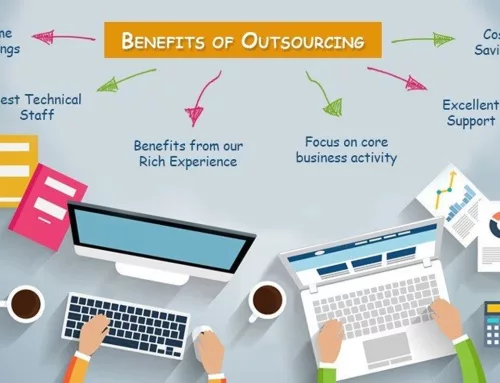In the rapidly evolving landscape of Information Technology (IT), businesses rely on a spectrum of IT support services to ensure the smooth functioning of their systems and to address technological challenges. This article delves into the various types of IT support services, providing insights into managed IT services, IT support and services, and the role of IT service providers in meeting the diverse needs of organizations.1. Introduction to Managed IT Services:
Managed IT services represent a comprehensive approach to outsourcing IT functions. Organizations that opt for managed IT services enlist the expertise of external service providers to proactively manage and monitor their IT infrastructure. This includes tasks such as network monitoring, security management, data backup, and system optimization. The goal is to enhance overall IT efficiency while allowing businesses to focus on their core operations.
2. Key Components of Managed IT Services:
Managed IT services encompass a range of components designed to address different aspects of IT management. These components may include 24/7 network monitoring, cybersecurity services, helpdesk support, software updates, and strategic IT consulting. The holistic nature of managed IT services aims to provide a one-stop solution for organizations seeking comprehensive IT support.
3. Benefits of Managed IT Services:
The adoption of managed IT services brings forth several benefits for organizations. These include predictable IT costs, improved system reliability, enhanced cybersecurity, access to a skilled IT team, and the flexibility to scale IT services based on business needs. Managed IT services align with a proactive approach to IT management, preventing issues before they escalate.
4. Navigating IT Support and Services:
IT support and services refer to the broader category of assistance and solutions provided to address various IT-related challenges. This includes both reactive support, where issues are addressed as they arise, and proactive services aimed at preventing potential problems. IT support and services can be delivered in-house or outsourced, depending on the organization’s preferences and requirements.
5. Types of IT Support:
IT support can manifest in different forms, each catering to specific needs. This includes desktop support, network support, hardware support, software support, and cybersecurity support. The diversity of IT support services ensures that organizations can tailor their support mechanisms to align with their unique IT infrastructure and challenges.
6. Importance of Helpdesk Support:
Helpdesk support is a fundamental component of IT support services. It involves a centralized service desk that provides end-users with assistance, troubleshooting, and issue resolution. Helpdesk support can be delivered through various channels, including phone, email, chat, and ticketing systems. An effective helpdesk is essential for maintaining user productivity and satisfaction.
7. On-Site vs. Remote IT Support:
Organizations can choose between on-site and remote IT support based on their preferences and requirements. On-site support involves IT professionals physically present at the organization’s location to address issues, while remote support allows for issue resolution without physical presence. The choice between the two depends on factors such as the nature of the issue, urgency, and the organization’s infrastructure.
8. The Role of IT Service Providers:
IT service providers play a crucial role in delivering both managed IT services and traditional IT support. These providers bring specialized expertise, advanced tools, and a proactive mindset to support the diverse IT needs of their clients. IT service providers may operate on a subscription-based model for managed services or offer tailored support packages.
9. Customization in IT Support Packages:
IT service providers understand that one-size-fits-all solutions may not align with the unique requirements of every organization. As a result, they offer customization options in their support packages. This allows organizations to choose services that specifically address their IT challenges, ensuring a tailored and effective approach to support.
10. Strategic IT Consulting:
Beyond day-to-day support, IT service providers often offer strategic IT consulting services. This involves collaborating with organizations to align their IT strategies with business objectives. Strategic IT consulting may include technology roadmaps, IT infrastructure planning, and guidance on adopting emerging technologies.
11. Scalability and Flexibility:
IT service providers are well-equipped to scale their services based on the evolving needs of organizations. Whether a business is expanding, undergoing a digital transformation, or facing specific IT challenges, service providers can adjust their support to ensure that IT infrastructure remains aligned with organizational goals.
12. IT Support in the Digital Era:
The digital era introduces new dimensions to IT support, including the adoption of cloud technologies, cybersecurity challenges, and the need for remote work support. IT service providers play a crucial role in helping organizations navigate these complexities and leverage technological advancements for strategic advantage.
13. Managed IT Services vs. Traditional IT Support:
While managed IT services and traditional IT support share the goal of maintaining IT functionality, they differ in their approach. Managed IT services provide a proactive, holistic, and outsourced solution, while traditional IT support can be either reactive or a combination of reactive and proactive, often handled in-house.
14. Evaluating IT Support Providers:
Selecting the right IT service provider is a critical decision for organizations. Factors to consider include the provider’s expertise, track record, responsiveness, scalability, and alignment with the organization’s values and goals. Evaluating providers ensures a strategic partnership that contributes to the organization’s long-term success.
15. Emerging Trends in IT Support:
As technology continues to advance, new trends in IT support emerge. This includes the integration of artificial intelligence for predictive issue resolution, the use of automation for routine tasks, and the emphasis on user-centric support experiences. Staying abreast of these trends is essential for organizations seeking to future-proof their IT support strategies.
Conclusion:
In conclusion, the realm of IT support services is multifaceted, encompassing managed IT services, traditional IT support, and the expertise of IT service providers. Navigating the diverse landscape of IT support requires organizations to align their support strategies with their unique challenges and objectives. Whether opting for managed services, traditional support, or a combination of both, organizations benefit from a well-rounded IT support approach that enhances efficiency, security, and overall IT resilience.
Managed IT services represent a comprehensive approach to outsourcing IT functions. Organizations that opt for managed IT services enlist the expertise of external service providers to proactively manage and monitor their IT infrastructure. This includes tasks such as network monitoring, security management, data backup, and system optimization. The goal is to enhance overall IT efficiency while allowing businesses to focus on their core operations.
2. Key Components of Managed IT Services:
Managed IT services encompass a range of components designed to address different aspects of IT management. These components may include 24/7 network monitoring, cybersecurity services, helpdesk support, software updates, and strategic IT consulting. The holistic nature of managed IT services aims to provide a one-stop solution for organizations seeking comprehensive IT support.
3. Benefits of Managed IT Services:
The adoption of managed IT services brings forth several benefits for organizations. These include predictable IT costs, improved system reliability, enhanced cybersecurity, access to a skilled IT team, and the flexibility to scale IT services based on business needs. Managed IT services align with a proactive approach to IT management, preventing issues before they escalate.
4. Navigating IT Support and Services:
IT support and services refer to the broader category of assistance and solutions provided to address various IT-related challenges. This includes both reactive support, where issues are addressed as they arise, and proactive services aimed at preventing potential problems. IT support and services can be delivered in-house or outsourced, depending on the organization’s preferences and requirements.
5. Types of IT Support:
IT support can manifest in different forms, each catering to specific needs. This includes desktop support, network support, hardware support, software support, and cybersecurity support. The diversity of IT support services ensures that organizations can tailor their support mechanisms to align with their unique IT infrastructure and challenges.
6. Importance of Helpdesk Support:
Helpdesk support is a fundamental component of IT support services. It involves a centralized service desk that provides end-users with assistance, troubleshooting, and issue resolution. Helpdesk support can be delivered through various channels, including phone, email, chat, and ticketing systems. An effective helpdesk is essential for maintaining user productivity and satisfaction.
7. On-Site vs. Remote IT Support:
Organizations can choose between on-site and remote IT support based on their preferences and requirements. On-site support involves IT professionals physically present at the organization’s location to address issues, while remote support allows for issue resolution without physical presence. The choice between the two depends on factors such as the nature of the issue, urgency, and the organization’s infrastructure.
8. The Role of IT Service Providers:
IT service providers play a crucial role in delivering both managed IT services and traditional IT support. These providers bring specialized expertise, advanced tools, and a proactive mindset to support the diverse IT needs of their clients. IT service providers may operate on a subscription-based model for managed services or offer tailored support packages.
9. Customization in IT Support Packages:
IT service providers understand that one-size-fits-all solutions may not align with the unique requirements of every organization. As a result, they offer customization options in their support packages. This allows organizations to choose services that specifically address their IT challenges, ensuring a tailored and effective approach to support.
10. Strategic IT Consulting:
Beyond day-to-day support, IT service providers often offer strategic IT consulting services. This involves collaborating with organizations to align their IT strategies with business objectives. Strategic IT consulting may include technology roadmaps, IT infrastructure planning, and guidance on adopting emerging technologies.
11. Scalability and Flexibility:
IT service providers are well-equipped to scale their services based on the evolving needs of organizations. Whether a business is expanding, undergoing a digital transformation, or facing specific IT challenges, service providers can adjust their support to ensure that IT infrastructure remains aligned with organizational goals.
12. IT Support in the Digital Era:
The digital era introduces new dimensions to IT support, including the adoption of cloud technologies, cybersecurity challenges, and the need for remote work support. IT service providers play a crucial role in helping organizations navigate these complexities and leverage technological advancements for strategic advantage.
13. Managed IT Services vs. Traditional IT Support:
While managed IT services and traditional IT support share the goal of maintaining IT functionality, they differ in their approach. Managed IT services provide a proactive, holistic, and outsourced solution, while traditional IT support can be either reactive or a combination of reactive and proactive, often handled in-house.
14. Evaluating IT Support Providers:
Selecting the right IT service provider is a critical decision for organizations. Factors to consider include the provider’s expertise, track record, responsiveness, scalability, and alignment with the organization’s values and goals. Evaluating providers ensures a strategic partnership that contributes to the organization’s long-term success.
15. Emerging Trends in IT Support:
As technology continues to advance, new trends in IT support emerge. This includes the integration of artificial intelligence for predictive issue resolution, the use of automation for routine tasks, and the emphasis on user-centric support experiences. Staying abreast of these trends is essential for organizations seeking to future-proof their IT support strategies.
Conclusion:
In conclusion, the realm of IT support services is multifaceted, encompassing managed IT services, traditional IT support, and the expertise of IT service providers. Navigating the diverse landscape of IT support requires organizations to align their support strategies with their unique challenges and objectives. Whether opting for managed services, traditional support, or a combination of both, organizations benefit from a well-rounded IT support approach that enhances efficiency, security, and overall IT resilience.





